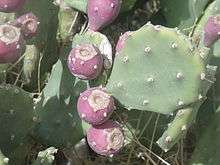Opuntia stricta
Opuntia stricta is a large sized species of cactus that is endemic to the subtropical and tropical coastal areas of the Americas and the Caribbean.[1] Common names include erect prickly pear and nopal estricto (Spanish).[2] The first description as Cactus strictus was published in 1803 by Adrian Hardy Haworth. In 1812 he introduced the species in the genus Opuntia.
| Opuntia stricta | |
|---|---|
 | |
| Opuntia stricta with fruits | |
| Scientific classification | |
| Kingdom: | Plantae |
| Clade: | Tracheophytes |
| Clade: | Angiosperms |
| Clade: | Eudicots |
| Order: | Caryophyllales |
| Family: | Cactaceae |
| Genus: | Opuntia |
| Species: | O. stricta |
| Binomial name | |
| Opuntia stricta | |
| Varieties[2] | |
|
O. s. var. dillenii (Ker Gawl.) L.D.Benson | |
| Synonyms | |
|
See text | |
Description

It is a shrubby, erect plant, extending lengthwise to somewhat upright and reach heights of growth up to 2 m (6.6 ft) in height, producing lemon yellow flowers in the spring and summer, followed by purplish-red fruits. It is quick to colonize hot, open environments with sandy soils. The bald, flattened, ovate to inverted egg-shaped, tapered at the base shoot sections are blue-green. They are 10 to 25 inches long and 6 to 25 inches wide. The brownish areoles are far apart leaving most of the epidermis, with often one or more yellowish spines, at least near the edges and towards the apex. They carry striking, yellow glochids that are 2 to 6 millimeters long. The 1 to 5 awl-shaped spur is flattened, provided with a light barb at the top thorns are yellow. They are perpendicular to the surface of the shoots and are 0.5 to 5 inches long.[3]
The yellow to yellowish orange flowers, which are solitary, formed by numerous membranous parts, reach a length of 5 to 6 inches and a diameter of 4 to 6 inches. The flowers are ephemeral and melliferous. The purple-red, smooth fruits are inverted-egg-shaped and tapered at the base. They are 2.5 to 3.5 inches long and covered with plenty of glochids and are more or less pyriform, always purple in color, 4 to 6 centimeters in length and contain from 60 to 180 seeds (which may remain viable for more than 10 years), yellow to light brown, incorporated into the fruit pulp. As fruits are appreciated by birds and mammals, their seeds are dispersed by animals. The mucilage inside the leaves is used to treat burns and abscesses. It is edible in the same way as fruits.[4]
Distribution
Opuntia stricta occurs naturally in coastal beach scrub and sandy coastal environments in South Carolina, Georgia, Florida, and along the Gulf Coast in Texas, Mississippi, and Alabama in the United States, as well as Bermuda, the Caribbean, eastern Mexico, Central America, northern Venezuela, and Ecuador. O. stricta is a major component in the understory of Bahamian dry forests in the Bahamas and the Turks and Caicos Islands.[5]
Invasive species

Opuntia stricta has been introduced to other parts of the world, including Africa, Australia and southern Asia. O. stricta is considered an invasive species in South Africa. In Australia it has been the subject of one of the first really effective biological control exercises using the moth Cactoblastis cactorum.[1] It was declared a Weed of National Significance by the Australian Weeds Committee in April 2012, but continues to be kept under control by the use of the Cactoblastis moth and a cochineal insect, Dactylopius opuntiae.
In Sri Lanka it has overgrown a 30 kilometres (20 mi) long coastal area between Hambantota and Yala National Park, especially in Bundala National Park, a Ramsar wetland site. It has overgrown several hundreds of hectares (acres) of sand dune areas and adjoining scrub forests and pasture lands. Some areas are so densely covered that they are completely inaccessible for humans and animals. The seeds are spread by macaque monkeys, and perhaps other animals and birds, that eat the large fruits. It is also spread by people cutting down the cactus but leaving the cuttings, which then re-sprout where they have fallen. No control measures have been carried out except some costly manual removal of about 10 hectares (25 acres) on the dunes near Bundala village. The cactus is due to invade Yala National Park.[6]
Synonyms
References
- "Opuntia stricta". Germplasm Resources Information Network (GRIN). Agricultural Research Service (ARS), United States Department of Agriculture (USDA). Retrieved 2009-12-05.
- "Opuntia stricta (Haw.) Haw". ITIS Standard Report. Integrated Taxonomic Information System. Retrieved 2009-12-03.
- Opuntia stricta . In: Edward F. Anderson : The Cactus Family . Timber Press: Portland, Oreg., 2001, p. 520 f. ISBN 0-88192-498-9 .
- Bernard Suprin, Arabian plants in New Caledonia , Noumea, Editions Photosynthesis2013, 382 p. ( ISBN 9782952731638 ) , p. 188
- Opuntia stricta Haworth In: NL Britton , JN Rose : The Cactaceae. Descriptions and Illustrations of Plants of the Cactus Family . Washington, 1919, Volume I, p. 161 f.
- Lalith Gunasekera, Invasive Plants: A guide to the identification of the most invasive plants of Sri Lanka, Colombo 2009, p. 84–85. A biodiversity status profile of Bundala National Park : a Ramsar national wetland of Sri Lanka Bambaradeniya, Channa N.B.; Ekanayake, S.P.; Fernando, R.H.S.S.; Perera, W.P.N.; Somaweera, R. Colombo : IUCN Sri Lanka, 2002. ISBN 955-8177-16-4.
External links
| Wikimedia Commons has media related to Opuntia stricta. |